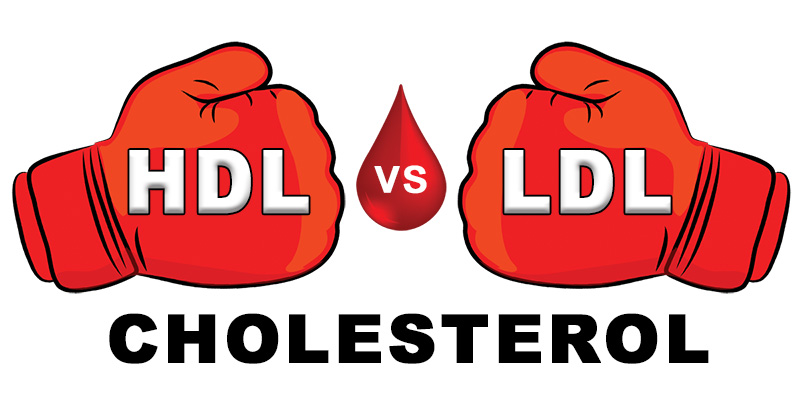What is the Difference Between HDL and LDL Cholesterol?
Cholesterol is a pliable substance that helps you make cell membranes, hormones, and vitamin D. Located in your blood, it is produced by your liver and comes from the foods you eat. Along with cholesterol, other fats like triglycerides are particles located in your bloodstream and are called lipoproteins. The most common lipoproteins are high-density lipoproteins (HDL) and low-density lipoproteins (LDL). If you’re wondering which is good cholesterol, HDL or LDL, the information provided below can help you understand the differences between the two and how to manage this aspect of your health.
HDL is commonly called “good cholesterol” because maintaining a healthy level can protect you against heart attack and stroke. While traveling in your blood, the HDL prevents blockages in your arteries by absorbing LDL (or “bad cholesterol”) and carrying it to your liver to be broken down and flushed from your body. Even though your liver produces HDL naturally, it can only eliminate about a third of the LDL in your bloodstream.
As mentioned, LDL cholesterol is normally referred to as “bad cholesterol” because it is the raw material of fat and plaque that clogs your arteries. LDL can stick to the arterial walls causing them to narrow, which is a condition called atherosclerosis. This buildup also increases your risk for more serious health issues like heart attack, stroke, and peripheral artery disease (PAD).
How Can You Calculate HDL and LDL Cholesterol Levels?
A lipid panel or lipid profile, also called a cholesterol test, is a blood test which measures the amounts of cholesterol and triglycerides in your blood. This test can determine your risk of developing fatty deposits in your arteries, which is important in diagnosing medical conditions like PAD.
It is important to know your optimal HDL and LDL cholesterol ratio. In the U.S., HDL and LDL levels are measured in milligrams (mg) of cholesterol per deciliter (dL) of blood. According to the Mayo Clinic, your total cholesterol should be below 200 mg/dL. Your HDL is best at a level above 60 mg/dL, and your LDL is best below 100 mg/dL.
Keeping your HDL levels above 60 mg/dL and your LDL levels below 100 mg/dL enables the good cholesterol to flush out the bad cholesterol in your bloodstream. When your HDL numbers are higher and your LDL numbers are lower, you are less at risk for vascular diseases like PAD and coronary artery disease (CAD).
Levels of lipoproteins vary by your age, weight, and gender. As you age, your body tends to produce more and more cholesterol, which is why managing and monitoring it is extremely important. Consult your doctor if you want to schedule a lipid panel or for more information about the effectiveness of at-home cholesterol test devices.
High Cholesterol and PAD
People that have high cholesterol levels often have PAD. The plaque from fats and cholesterol in the bloodstream that are deposited inside artery walls can cause atherosclerosis. When you have blockage in your arteries, blood flow to your legs is reduced and your body cannot get the oxygen and nutrients it needs to your lower extremities. As the buildup progresses, it may lead to peripheral artery disease.
Symptoms of PAD include pain in your legs, hips, and thighs, especially after walking or climbing stairs. Other indicators are skin discoloration or non-healing wounds on your lower extremities. If left untreated, PAD can cause even more serious health conditions such as heart attack, stroke, or limb amputation.
If you think you have high cholesterol or are experiencing symptoms of peripheral artery disease, there is hope. At USA Vascular Centers, minimally invasive treatment options are available that can alleviate your symptoms and help you manage your cholesterol. Consult with a vascular specialist to get the care you deserve to get back on your feet.
How To Lower Your LDL Cholesterol Levels
If you have high amounts of bad cholesterol in your body, you may wonder what’s the best way to reduce it and keep it at a lower level. Primarily, maintaining a healthy lifestyle is the best course of action to reach this goal. If you have PAD, make sure to consult with your doctor before adding new restrictions to your diet or increasing the amount of your daily exercise.
Meal planning can help you focus on healthier options and is a good way to start lowering your cholesterol. A good tip is to consume more unsaturated fats in your diet. The American Heart Association suggests that 8 to 10% of daily calories should come from polyunsaturated fats, and there is evidence that eating more of the good fats in place of saturated fats can lower your vascular disease risk.
When thinking ahead for your meals each week, try to replace dense proteins like beef, processed foods like boxed meals, and salty or sugary snacks with foods with good cholesterol in them. Fish like salmon, avocados, nuts, and seeds, have good cholesterol that can raise your HDL levels in your body and flush out your arteries. You should also limit eating foods with added sugars or excessive quantities of salt. Increasing the amount of water you drink daily is also helpful, particularly if it is in place of sodas or alcoholic beverages.
How to Raise Your HDL Cholesterol Levels
One way to raise your good cholesterol is to become more active. Physical activity can raise your HDL levels and flush out the fats in your bloodstream. It is suggested to exercise at least 30 minutes per day for five days a week.
If you have PAD, walking, swimming, or biking are activities that may help your condition while lowering your cholesterol. However, make sure to determine the level of activity you can participate in with your doctor. It is important to add these lifestyle changes in correlation with treatment to lower your symptoms and stop the progression of the disease.
By increasing your physical exertion and watching your dietary intake, you can maintain a healthy weight which helps lower your risk of high cholesterol. It can also have a positive outcome your overall health and stop the advancement of conditions such as diabetes, atherosclerosis, and PAD.
Contact USA Vascular Centers Today
If you have high cholesterol, you may have or be at risk for PAD. It is important to catch the condition before it progresses into something more serious. For more information, contact us at 888.773.2193 or schedule online for your initial consultation with a vascular specialist.



